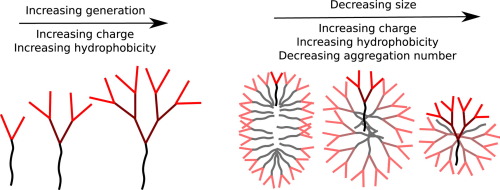Journal of Colloid and Interface Science ( IF 9.9 ) Pub Date : 2018-09-12 , DOI: 10.1016/j.jcis.2018.09.005 Leonardo Chiappisi , Uwe Keiderling , Carlos E. Gutierrez-Ulloa , Rafael Gómez , Mercedes Valiente , Michael Gradzielski

|
Hypothesis
Ionic dendronic head groups possess very different structural features than simple surfactant head groups. Accordingly, their self-assembly behavior is expected to differ from that of conventional surfactants. The number of generations of the headgroup should play a particularly relevant role.
Experiments
A novel type of surfactants with different dendronic head groups (cationic and anionic) was studied in this work. A systematic variation of the number of generations of the head group (n = 1, 2, and 3), of the head group charge (cationic and anionic), and of the length of the hydrophobic chain (hexanoyl and hexadecanoyl chains) was performed and the self-assembly behavior probed by means of small-angle neutron scattering (SANS) in order to obtain detailed structural insights.
Findings
The analysis of the scattering data shows that the general packing parameter concept applies also to dendrimeric surfactants and a larger head group results in smaller aggregates. However, in contrast to conventional surfactants, increasing the head group size results in a stronger tendency to self-aggregate, as a consequence of the head group’s partly hydrophobic character. Another peculiarity of the self-assembled aggregates, is the low aggregation numbers and the high water content within the micelle, as a result of the highly branched head group.
中文翻译:

具有阳离子和阴离子树突头基的表面活性剂的聚集行为
假设
离子树突状头基与简单的表面活性剂头基具有非常不同的结构特征。因此,预期它们的自组装行为不同于常规表面活性剂。总部的几代人应发挥特别重要的作用。
实验
在这项工作中,研究了具有不同树突头基团(阳离子和阴离子)的新型表面活性剂。对头基的代数(n = 1、2和3),头基电荷(阳离子和阴离子)和疏水链的长度(己酰基和十六烷酰基链)进行了系统的变化并通过小角度中子散射(SANS)探测自组装行为,以获得详细的结构见解。
发现
散射数据的分析表明,一般堆积参数概念也适用于树枝状表面活性剂,较大的头基团导致较小的聚集体。然而,与常规表面活性剂相反,由于头基团的部分疏水性,增加头基团的尺寸导致更强的自聚集趋势。自组装聚集体的另一个特殊之处是,由于高度支化的头基,胶束中的聚集体数量少且含水量高。



























 京公网安备 11010802027423号
京公网安备 11010802027423号